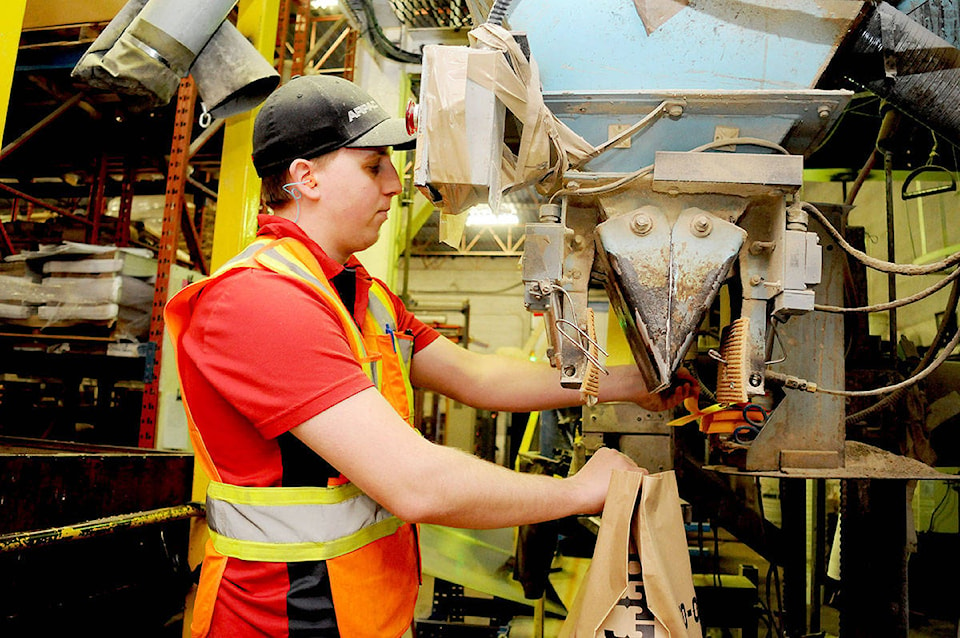TROY LANDREVILLE
Times Reporter
Otter Co-op is celebrating its 95th year, and a big part of the Co-op is animal feed.
Situated on the east side of 248 Street, right across from the grocery/hardware/clothing store, the the Co-op’s Feed Division produces food for pets, livestock, and zoo animals across the Lower Mainland.
“We manufacture all sorts of feed, and all different types of feed for whatever animal you can imagine,” explained Vafa Alizadeh, the feed division manager with Otter Farm &Home Cooperative.
“Domestic animals, to (the Greater) Vancouver Zoo, pet food, birdseed for wild birds, chickens of all sorts, dairy cattle, sheep, mountain sheep, goats, giraffes, hippos, camels, llamas, alpacas, ducks, geese…”
The feed division employs 57 people at its two locations, which include its plant and warehouse in Aldergrove as well as a dairy feed plant in Armstrong, B.C.
The Aldergrove plant annually manufactures 75,000 tons of different kinds of animal feed with $42 million in total sales.
If nature continues on its regular course, it’ll be business as usual at both operations.
“As long as people eat, we’re going to have demand for feed, too, because you’re feeding the animals,” Alizadeh said.
The Aldergrove plant is also “heavily involved” in the local equine community, Alizadeh noted.
“We make horse feed, too,” Alizadeh said. “We’re working very close with Thunderbird (Show Park). We are the sponsor of their feed.”
One thing that has changed over the years is how the feed is processed.
“Technology has changed a lot,” Alizadeh said. “It’s a lot more computerized, a lot less labour intensive. I remember even 10 years ago we used to stack bags of feed manually on pallets. Now it’s all robotic; it’s all automized here.”
Alizadeh said the tonnage of feed that’s produced is very steady from year to year.
“Most of the market for the dairy and chicken layers, and meat birds, are controlled by the marketing boards and a quota system that they have in place,” Alizadeh said. “So that pie is not really growing as much. It’s not a free enterprise kind of a thing.”
One aspect of the industry that is growing, is pet food and sacked feed.
“We are a big provider of sacked feed in the province,” Alizadeh noted. “And also, we’re dabbling a bit into fertilizer and bird feed and supplements for animals.”
Alizadeh said the future of the feed industry is “kind of guaranteed,” unless the North American Trade Agreement is reworked or ripped up altogether.
“If something happens to our marketing situation the way it is, and the quota system, obviously the farmers are not going to be guaranteed and protected,” Alizadeh said.
“So it would be a U.S.-style of free-for-all.”
If this happens, prices wouldn’t be protected.
“So the consumers maybe in the short term benefit a little bit, but the problem is the farmers don’t have a sustainable business, so they cannot operate,” Alizadeh said.
“Then, when that happens, the bigger outfits would dictate the prices.
“Our customers are not going to be guaranteed for their income, therefore we wouldn’t be guaranteed that they’re going to have the money to pay our bills.”
For the time being, Alizadeh pointed out, as long as there is population growth “we’re going to have growth of our product being sold to the farms.”
95 YEARS AND COUNTING
The Otter Co-op was incorporated in 1922, under the Provincial Societies Act, as Otter District Farmers’ Institute, with 25 members from the Otter region.
The aim of the institute was to promote agriculture and agricultural knowledge, to work for farm legislation, to improve farm conditions, and to buy supplies, at cost, for members.
During its first five years, the institute provided a wide variety of services including: meeting on potatoes, poultry, and pruning; a bull was rented from the government for herd upgrading; petitions to government for daily mail service; and 10 cent bounties for crows.
An original bylaw said that one of the aims of the institute was “to improve conditions of rural life so that settlement may be permanent and prosperous.”
This and many other bylaws remained in effect until June 22, 1979 when it officially became a co-op.



